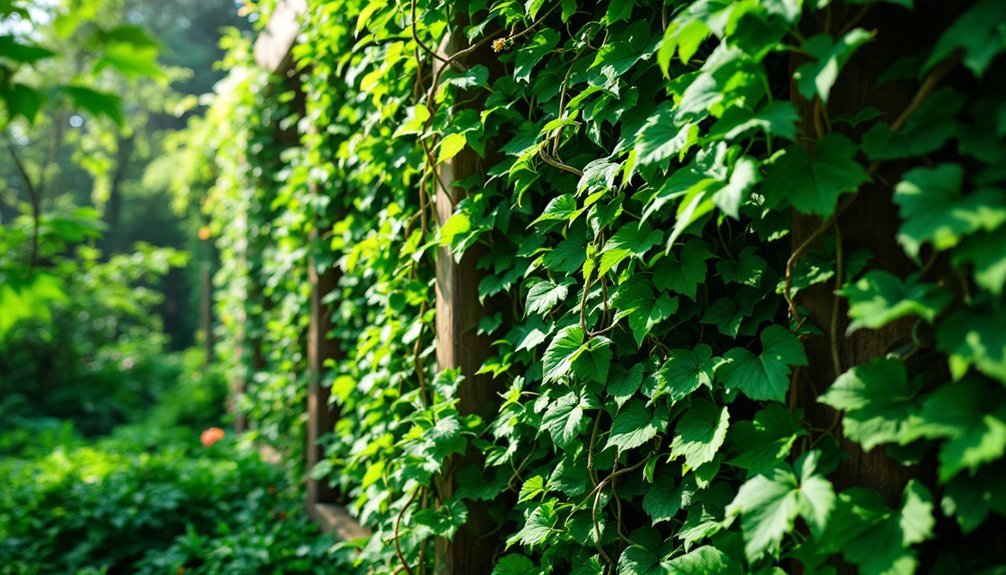To create an impenetrable garden barrier, combine multiple barrier types including trenches with stone or concrete. Select dense species like Western Red Cedar or English Laurel, planting them at half their mature width for thickness. Prune during dormancy to encourage robust spring growth. Prepare soil thoroughly with compost and organic matter before planting. Add a quality weed barrier with proper overlaps and mulch to suppress competition. These techniques will transform your ordinary hedge into a fortress-like boundary.
5 Tips For Thick Impenetrable Garden Barriers

When creating a robust barrier for your garden, you'll need more than just basic fencing to keep unwanted visitors at bay. Consider combining multiple barrier types for maximum effectiveness—install deep trenches filled with stone or concrete blocks around the perimeter, then add fencing above.
For the most resilient barriers, dig trenches at least 6 inches deep before installing edging or fencing. This prevents weeds from creeping underneath while creating a cleaner landscape line. Choose durable materials like metal edging for longevity or vinyl-coated chicken wire for pest resistance. Limestone screenings can provide an excellent weed-resistant base in trenches while creating a smooth surface for lawn maintenance equipment.
Don't forget maintenance—it's essential for barrier effectiveness. Schedule seasonal inspections to repair damage, reset loose stones, and remove encroaching plants.
For specific pests, adjust your barrier height and materials accordingly, ensuring complete protection for your garden investment.
Selecting the Right Hedge Species for Dense Growth
Beyond physical barriers like trenches and fencing, living hedges offer natural protection while enhancing your garden's beauty.
For impenetrable growth, consider coniferous options like Western Red Cedar or Leyland Cypress, which provide rapid, dense coverage but require regular maintenance.
Deciduous alternatives like Beech and Hornbeam retain their leaves through winter, filtering rather than blocking wind—an advantage over solid barriers.
For evergreen density, English Laurel and Waxleaf Privet adapt to various conditions while creating solid screens.
Native species offer environmental benefits; plants like Sea Buckthorn attract wildlife while forming effective barriers.
Remember that fast-growing species deliver quick results but demand more pruning, while slower growers like Yew require less maintenance long-term.
Match your selection to your patience level and maintenance capacity.
When purchasing plants for your impenetrable hedge, consider using smaller transplants called whips as they establish more rapidly than larger, more mature plants.
Proper Spacing and Layout for Maximum Coverage

Proper spacing forms the foundation of effective garden barriers, determining both their density and long-term success. To create impenetrable barriers, plant shrubs at half their mature width or closer, which encourages upward growth and creates dense coverage.
For ground covers, consider your climate and desired timeline – closer spacing (6-8 inches) provides faster results but might require future thinning. Install quality weed barriers with 5-10 inch overlaps to prevent unwanted intruders. For more efficiency, consider using landscape plugs to rapidly establish ground cover in large spaces.
| Plant Type | Warm Climate Spacing | Cold Climate Spacing | Fill-in Time |
|---|---|---|---|
| Small Shrubs | 18-24 inches | 12-18 inches | 1-2 years |
| Large Shrubs | 36-48 inches | 24-36 inches | 2-3 years |
| Ground Covers | 10-12 inches | 6-8 inches | 6-12 months |
| Ornamental Grasses | 24-30 inches | 18-24 inches | 1 year |
Strategic Pruning Techniques to Encourage Thickness
Strategic pruning transforms ordinary garden barriers into dense, impenetrable shields against unwanted views and intruders. By selectively thinning overcrowded areas and heading back branch ends, you'll stimulate fuller growth where you need it most.
Timing is essential—prune during dormancy to enhance spring growth, while avoiding periods when your plants are stressed. Pruning in late winter provides optimal healing time before the growing season begins.
- Remove entire branches with thinning cuts to improve structure and allow light to penetrate deeper, triggering interior growth.
- Cut just above outward-facing buds to direct new growth and create a thicker exterior barrier.
- Eliminate water sprouts and weak crotches to redirect energy toward stronger, more sustainable growth patterns.
Maintain your tools properly to guarantee clean cuts that heal quickly and prevent disease spread, keeping your living barrier healthy and robust.
Soil Preparation and Feeding for Vigorous Barrier Plants

The foundation of thriving garden barriers lies in carefully prepared soil that supports vigorous growth and long-term stability. You'll need to create a balanced soil structure through double digging and incorporating organic matter to improve drainage and aeration. Consider using the 103 soil mix with equal parts topsoil, coarse sand, and compost for optimal barrier plant development.
Test your soil before adding amendments to identify specific nutrient needs. Apply compost, manure, or organic fertilizers to provide essential nutrients without overwhelming your plants.
| Amendment Type | Benefits | When to Apply | Amount |
|---|---|---|---|
| Compost | Improves fertility & structure | Spring/Fall | 2-3" layer |
| Manure | Boosts nitrogen & phosphorus | Fall | 1" layer |
| Organic Fertilizer | Targeted nutrient boost | Growing season | Per package |
| Mulch | Retains moisture & suppresses weeds | After planting | 2-4" layer |
Don't forget to adjust your feeding strategy based on your climate and plant selection.
Frequently Asked Questions
How Do I Prevent Animals From Burrowing Under My Garden Barrier?
Prevent animals from burrowing under your barrier by burying wire mesh at least 12 inches deep. You'll also want to use hardware cloth, add gravel, and regularly inspect for weaknesses in your defenses.
Can I Combine Different Materials for a More Effective Barrier?
Yes, you can combine different materials for a more effective barrier. Try pairing wire mesh with wood for aesthetics, or concrete footings with metal fencing. These combinations enhance both security and durability against animal intrusions.
What's the Best Barrier Solution for Extremely Windy Locations?
In extremely windy locations, you'll want metal fencing with 20-30% permeability. Position barriers perpendicular to prevailing winds, reinforce posts with concrete, and add windbreaks like shrubs on the windward side for protection.
How Do I Maintain Barrier Plants During Severe Drought Conditions?
Water deeply but infrequently to encourage deep root growth. You'll need to apply thick mulch, choose drought-tolerant species, and monitor plants for stress signs. Don't prune during drought as it causes additional stress.
Are There Non-Toxic Barrier Options Safe for Pets and Children?
Yes, you'll find many pet and child-safe barrier options. Choose vinyl or wooden fencing, non-toxic plants like roses and marigolds, and smooth surface materials. Designated play areas further enhance safety for your little ones.
In Summary
You'll find that creating an impenetrable garden barrier requires consistent attention and the right approach. By selecting appropriate species, spacing plants strategically, pruning regularly, and maintaining proper soil conditions, you're well on your way to establishing the privacy and security you desire. Remember, the most effective barriers develop over time, so be patient as your living fence transforms into a dense, protective boundary.





Leave a Reply